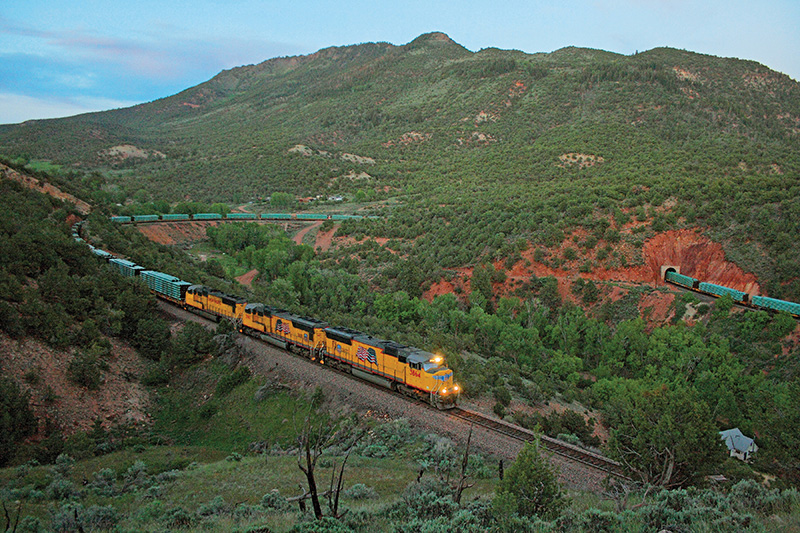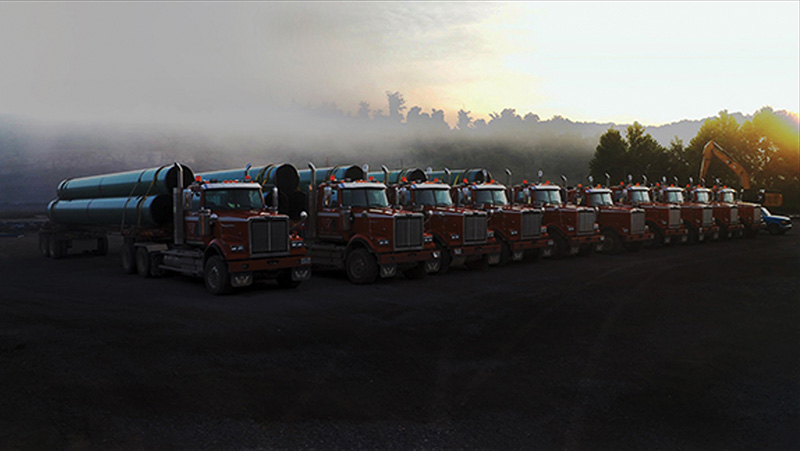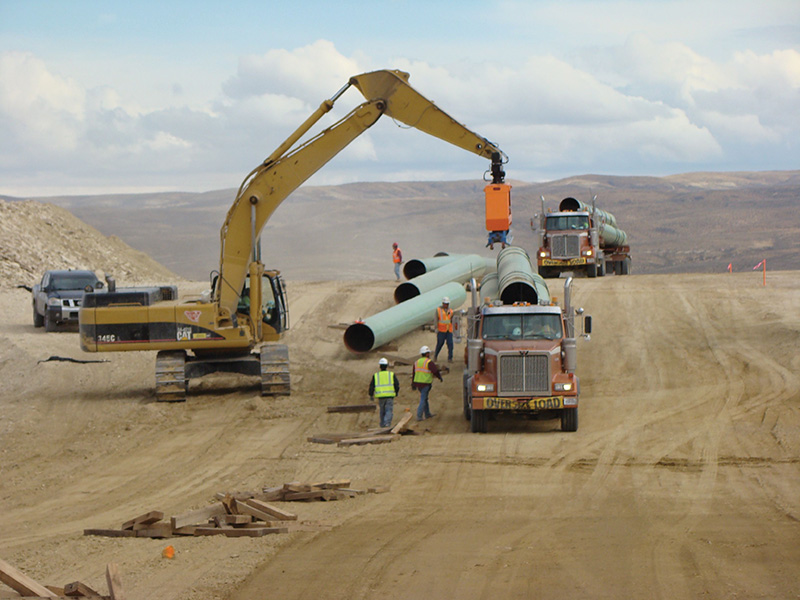November 2022, Vol. 249, No. 11
Features
The Forgotten World of Moving the Pipe
By Richard McDonough, P&GJ North America Correspondent
(P&GJ) — There are three major ways of moving pipeline sections from fabrication in a factory to placement in the ground in a right-of-way in North America.

The two most frequently used methods involve a combination of rail and trucking or the use of trucking by itself. The third method, barge transport, is available in more limited sections of North America.
The decision of which transport method to use is based on several key factors, including costs, accessibility, and availability of needed resources. The boom-and-bust cycle of pipeline construction projects, regulatory actions, and general economic conditions affect each of these factors.
The logistics of the transport of pipeline sections may be handled in several ways. In some situations, a railroad or a trucking firm coordinates both internal operations as well as relationships with third parties needed for the transit of pipeline sections.
In other cases, a pipeline operator or its mainline contractor will use the services of a logistics firm to coordinate all of the different aspects of the transportation of pipeline sections – from manufacturing site to stockpile yards to placements within rights-of-way.
Among the benefits of using rail, according to Union Pacific Railroad, is that “a single Union Pacific train can carry the freight of more than 300 trucks…[and that] one Union Pacific rail car can hold up to four times the freight of a single truck.”
This railroad, with tracks in 23 states throughout the western and central sections of the United States, is one of the largest transporters of pipeline sections in the country. The company “…transports seamless and ERW [electric-resistance welded] and OCTG [oil country tubular goods] tubing and casing, line pipe, and structural pipe,” said Robynn Tysver, Manager II Communications of Union Pacific Railroad. “We work with both domestic suppliers as well as imports.”
BNSF Railway is another railroad that moves large volumes of pipeline sections in North America. According to a spokesperson for the railroad, the company “…moves solid 80-foot coated and non-coated pipeline in bulk unit trains on 89-foot flatcars, usually consisting of 70 to 80 cars. Additionally, we move flexible steel pipe coils in merchandise service.”
Providing transport in 28 states and three Canadian provinces, BNSF Railway includes about 32,500 miles (52,300 km) of track in its network, according to the company.

Rail Transport Planning
Tysver cited that planning and communication is key for the transport of pipeline sections, noting that, “it is crucial to have as much advance notice as possible as there needs to be additional planning and work done before the pipe is shipped.”
As an example, she cited the need to review the availability of rail service at both the origin and destination locations.
“Customers cannot offload at just any location near a track,” Tysver explained. “Union Pacific along with our subsidiary, Loup Logistics, offers Pipeline Express, which helps customers identify offloading sites near the pipeline rights-of-way and provides logistical support from start to end … We can also communicate with other railroads to help locate optimal offloading sites.”
Safety is paramount, whether transit is by rail or by truck.
Other items to consider when using rail transport include arranging for the needed equipment – both within a railroad company itself as well as from others involved in the logistics of transit of pipeline sections. Tysver indicated that the railroad needs “…to understand the dimensions of pipe to ensure the proper railcar is used.”
“It is really important to ensure that track and land agreements are acquired prior to shipping,” she continued. “Another thing is to work with the offloader, as they need to be prepared to receive the loaded cars. Unloading procedures can vary depending on the railcar and size of the pipe. For example, a line pipe shipment loaded on a flatcar will need to be unloaded using a vacuum lifter (on a forklift or crane) to not cause damage to the coating of the pipe.”
BNSF adheres to the Association of American Railroads’ Open Top Loading Rules for transporting pipeline, which provides guidelines based on the type of pipe and the diameter.
“We supervise customer loading of pipeline and perform random inspections on cars to ensure personnel followed the proper safety protocols,” the BNSF spokesperson said. “Depending on the size and quantity, unit trains will typically have buffer cars at either end to safeguard against load shifting during transportation.”
The destination requires cranes and the proper laydown space, the spokesperson continued, and unloading requires clearance to store the bulk material and prepare for the last-mile delivery of the product.
Trucking Transport
Trucking is a critical component of the transport of pipeline sections in North America. Few pipeline sections are moved directly on one truck from the site of manufacturing to placement in the ground.

Instead, in many cases, a section of pipe moves from the site of its fabrication or from a rail yard to a stockpile yard near its eventual destination. A separate truck will then move the pipeline section from a stockpile yard to its placement in a right-of-way.
Some trucking firms handle individual segments of the pipe transport, while others have the capabilities to provide each of the transit segments within their business.
Pe Ben USA is one of the firms that has capabilities to handle each of the transport segments of moving pipeline sections. MTS Canada is a subsidiary of Pe Ben USA and serves the Canadian market. The company indicated that it works with pipeline operators, pipe manufacturers and mainline contractors.
“In many cases, it’s more efficient for our company to move the pipe,” said Matt Moore, general manager of Pe Ben USA. “We’re able to transport pipeline sections to meet customer needs. We can move pipe from the manufacturer to a staging area, from a rail spur to a staging area, and from the staging area to a right-of-way.”
Pe Ben USA noted that, “We are pioneers in developing and using technology that later becomes known as the industry standard. Our vacuum lifts are one example. Our lifts, designed with high-powered suction capabilities, can move steel with ease.” In addition, the firm detailed that it uses self-steering pole trailers that have
“... built-in safety ... [that allow] our drivers to safely go around corners and make turns that other trucks are not able to complete.”
Healthy Demand
Demand to transport pipeline sections appears to be on the increase.
“Requests for bids are up,” said Moore. “Year over year, we’re seeing a 300% increase in bid requests from 2021. This increase is a welcome sign for the industry as a whole. It shows that new construction is on the way.”
BNSF Railway also indicated that the railroad is seeing an increase in demand for transport of pipe.
“The determining factor for pipeline transportation over the past two years has more to do with the lack of projects and a surplus of pipeline remaining from the canceled Keystone Pipeline project,” according to a spokesperson of BNSF Railway. “However, we are beginning to see a return of interest due to carbon-catcher and LNG [liquefied natural gas] pipeline projects that are currently emerging from regulatory hurdles.”
“Our niche is in the transport of QRL pipe,” Moore continued. “Many of the pipeline projects in West Texas use these larger pipes, and we have the trucks that can move them. We also have the trucks that can move the TRL and DRL [triple random length and double random length] pipe that is typically more in demand in pipeline projects in the East, from Florida to Pennsylvania.”
Challenges
Some of the supply chain and logistical aspects of the general economy have been affecting the transit of pipeline sections. Supply chain difficulties have hampered availability of the raw materials needed by the pipe mills, according to Moore. He also noted that changes in the rail industry – implementing progressive railroading operations – have created challenges for the transit of pipeline sections.
Another quandary facing the industry has been the turnover of drivers.
Part of this, Moore explained, is related to the boom-and-bust cycles within the industry that makes it difficult to retain employees when demand is slow.
He noted that a number of the drivers have left the industry in recent years. Some retired during the height of the COVID-19 pandemic, while others have gone to work for large corporations and big-box stores that handle deliveries in-house.

“Some have left because they’re looking for a specific type of life/work balance,” said Moore. “These drivers want to be able to work full-time, get higher pay and still be able to go home at night to sleep in their own bed. They don’t want to be on the road for days at a time – sleeping in a hotel or in an R/V.”
Pe Ben USA indicated that its truck drivers are members of the Teamsters Union; many of the drivers hauling pipeline sections are single men or single women.
“We recently ran a successful driver recruitment effort to secure additional drivers,” said Moore. “Our drivers have a sense of pride in the work they do. They are among the most skilled workers, and they thoroughly enjoy this type of trucking. There’s a certain spirit to hauling pipe. They know that they’re contributing to the betterment of our country.
“We have not had as much of a challenge with the operating engineers that handle specific jobs with the pipeline sections.”
Future Growth
Moore noted that the demand for transport of pipeline sections only occurs at the end of a lengthy process.
“People see a need for a new pipeline,” Moore stated. “Plans need to be developed. Regulatory approvals need to be secured. Rights-of-way need to be purchased. Construction needs to be planned. The pipe needs to be manufactured. It’s at that point that transportation is needed.”
Demand for the services of businesses like Pe Ben USA are likely to increase in the near-term.
“We anticipate that Quarter 2 and Quarter 3 of 2023 will be the start of a very busy cycle,” said Moore.
Author: Richard McDonough, writes on energy infrastructure-related issues in North America, including the column “The Nuacht Of Pipelines.” He can be reached at newsaboutamerica@gmx.us.






Comments